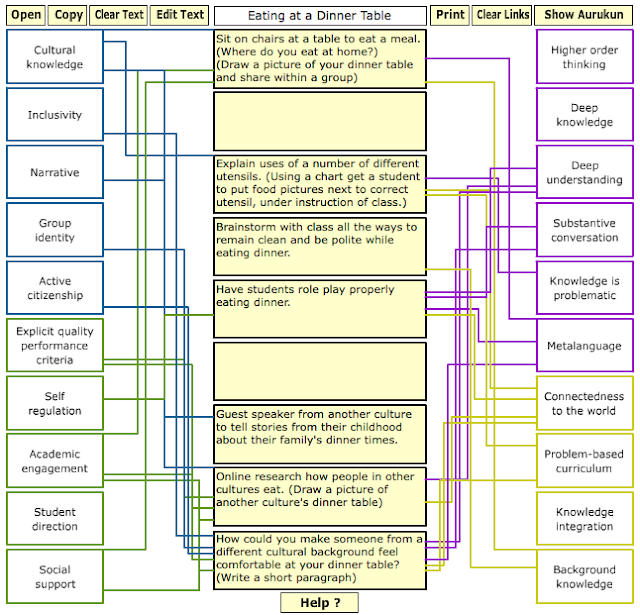To explore the use of productive pedagogies
in planning a lesson, I devised a lesson plan to instruct students how to eat
at a dinner table. My initial thoughts
were that this type of information was very applicable to the students’ real
life, and so would fulfill many of the productive pedagogies’ criteria.
My initial attempt at creating a short
learning sequence and then linking it to the productive pedagogies resulted in
a step-by-step explanation of how a formal dinner would function. I quickly discovered that very few of my
steps actually linked to any of the productive pedagogies. Productive pedagogies is not primarily about
what type of content is being taught to the students. It is about how that information is being
delivered, what you are asking the students to do with that information and
what is the real-world and world-wide importance of that information.
Here is my altered short learning sequence
with linked productive pedagogies:
To address the problems in my first attempt
at the learning sequence, I first looked at the way the content was going to be
presented to the students. My original
design had the teacher simply telling the students what they needed to
know. I added in a class brainstorming
session so that information could be gathered from the students’ background
knowledge. There was also no narrative
aspect, so I included the use of a guest speaker to tell stories from their
childhood.
I then had to look at what I was asking the
students to do with the information they were being given. I added a role playing session, which would
allow the students to practice the types of behaviours required in real life,
show that had gained deep understanding on the topic and hopefully create
substantive conversation between students during the activity. I also added in the utensils and food chart
so the students would have an opportunity to problem solve.
A major deficiency in my original design
was that it did not address the “Recognition of Difference” dimension at
all. This was fixed by simply adding an
activity on the end of the lesson that required the students to research the
same information but from other cultures.
By adding a reflective piece the students also had to identify how they
could personally apply this new information to their own lives, covering the
inclusivity, group identity and citizenship aspects of this dimension.
Going through this activity has taught me
that there is much more to teaching than simply being able to identify the type
of content the students need to learn. It
has also shown me which productive pedagogies I don’t fully understand. I especially had difficulties trying to find
a way to link “higher order thinking” and “deep knowledge” to the lesson plan. Productive pedagogies provides a framework for
lesson planning to ensure that the students will learn much more from a lesson
then simply how to eat politely at a dinner table.

No comments:
Post a Comment